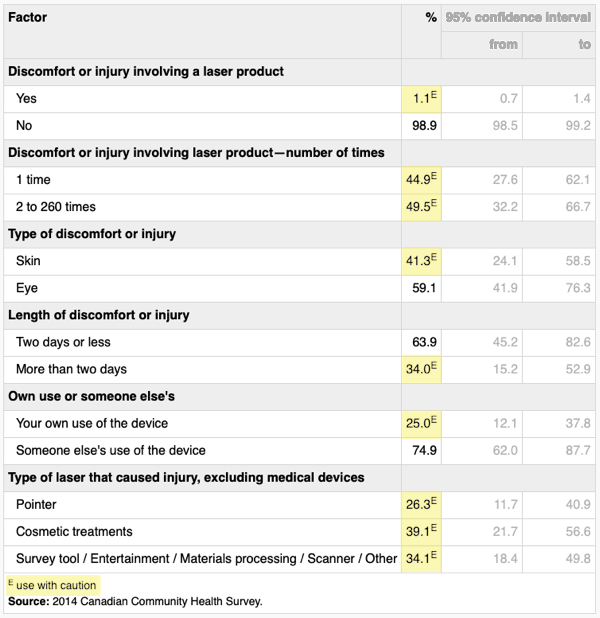Home
A comprehensive resource for safe and responsible laser use
Canada: Study first to show prevalence of laser use, injuries among general public
It showed that 48 percent of Canadians over the age of 12 either used or were exposed to lasers, annually.
Of those who reported using a laser product, 1.1% reported discomfort or injury.
[LaserPointerSafety.com analysis: Based on 2016 Canadian census data, there were 29,312,165 Canadians age 15 or older — data was not available on age 12+. If 48% of these 29 million Canadians used or were exposed to lasers, that would be just over 14 million people. If 1.1% of them experienced discomfort or injury, that would be about 155,000 Canadians with laser discomfort or injury.]
Returning to the Statistics Canada study, of the discomfort/injury cases:
- 41% were for skin injuries "such as rash, itch or pain," while 59% were for eye injuries "such as itchiness, pain, visible floating objects, blurred vision, burn, flash blindness, excessive watering or loss of sight."
- In 64% of cases, the discomfort or injury lasted less than two days; in 34%, it lasted more than two days.
- The discomfort/injury was caused by the person's own use of the laser in 25% of cases, and by someone else's use in 75% of cases.
- 39% of the discomfort/injury cases were caused by cosmetic treatments, 26% were caused due to laser pointers, and 34% were caused by "other" which included surveying tools, entertainment lasers, materials processing, and scanners.
The study analyzed published eye injury case reports since 1999, and concluded:
"…the majority involved the misuse of a handheld battery-operated laser product by an adult or a child. Most of these injuries were the result of irresponsible use or deliberate staring at a laser by a child, or the result of the inappropriate use of a high-powered laser device (Class 3B or 4) in an 'uncontrolled environment'....In the cases reported in 2014 that included long-term follow-up injury reporting, about one-half of the ocular injuries resolved within one to two weeks, with the other 50% of patients sustaining longer-term visual impairments."
Three limitations of the study were noted:
- The assessment for injuries was not ideal because the questionnaire did not report the specific type of injury incurred to each tissue type (i.e., eye [flash blindness, floaters or loss of sight] or skin [burns, pigment change or scarring]) and included discomfort in the same category.
- Respondents were asked about injuries from lasers sustained only in the previous 12 months. Lifetime injuries, particularly among older respondents who no longer use such devices, may have provided a more comprehensive picture of the injury prevalence.
- Because of the small sample size of reported injuries, the statistics regarding the type of laser product (excluding medical devices) that caused the injury were coded as “E.” This indicates a high degree of variability and that they should be interpreted with caution.
The study's Conclusion section stated:
"The Canadian Community Health Survey findings indicate that consumer laser product usage and exposure are very prevalent among Canadians aged 12 and older. A detectable number of discomfort or injury cases within the past year were reported in this survey. Moreover, strong associations were observed between certain groups (e.g., age, sex), the type of devices that were used and the types of injuries reported. The data show that cosmetic laser treatments place females at greater risk for skin injury and that males are at greater risk of eye injury related to the use of survey tools, pointers or entertainment devices employing lasers. In summary, the majority of the laser injuries reported in this survey occurred to the eyes, as compared with the skin, and were usually the result of usage by another person."
From Prevalence of laser beam exposure and associated injuries, released January 16 2019. By Sami S. Qutob, Michelle O’Brien, Katya Feder, James McNamee, Mireille Guay and John Than. Below are two tables from the study; the third table (Table 1) has demographics of the survey respondents and is not shown here.
Table 2 (partial): Weighted distribution of respondents who have used or been exposed to laser equipment, by product type, in past year, selected characteristics, household population aged 12 or older, Canada excluding territories, 2014.
Table 2 in the Statistics Canada study also breaks down these items by Males and Females. For this article, we have just shown the Totals data (males + females).
Table 3: Weighted distribution of respondents who used or were exposed to a laser beam over the past 12 months who experienced discomfort or injury involving a laser product, household population aged 12 or older, Canada excluding territories, 2014.
Items flagged with "E" and yellow highlighting above indicate a small sample size and high degree of variability, so data "should be interpreted with caution."